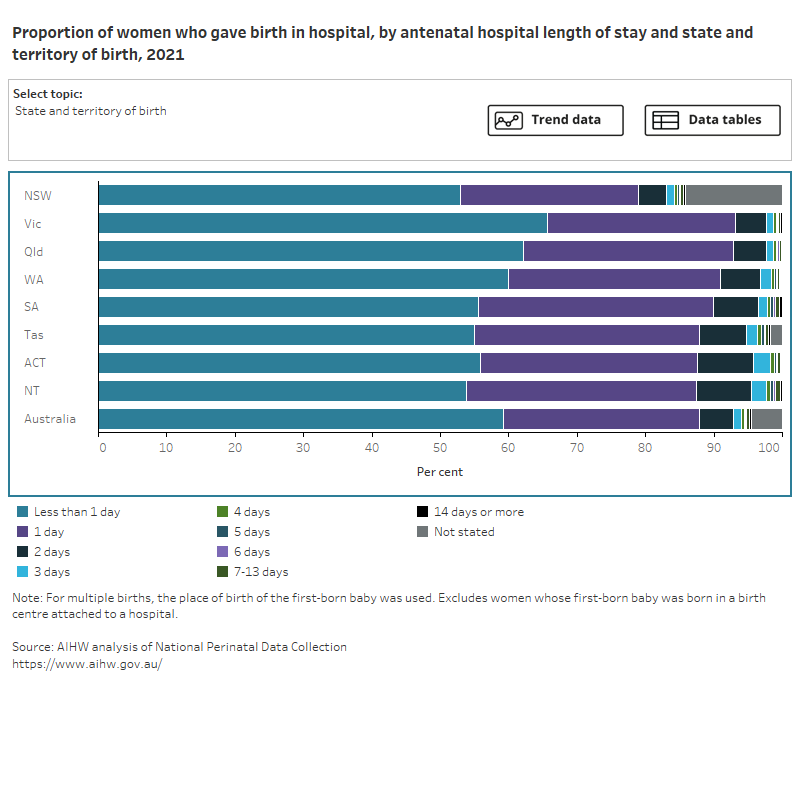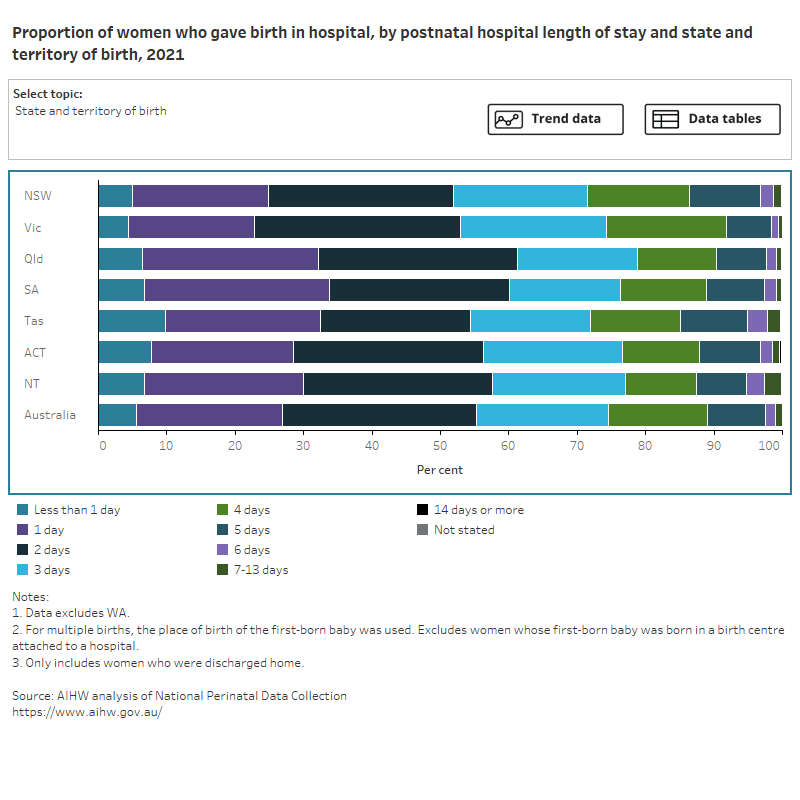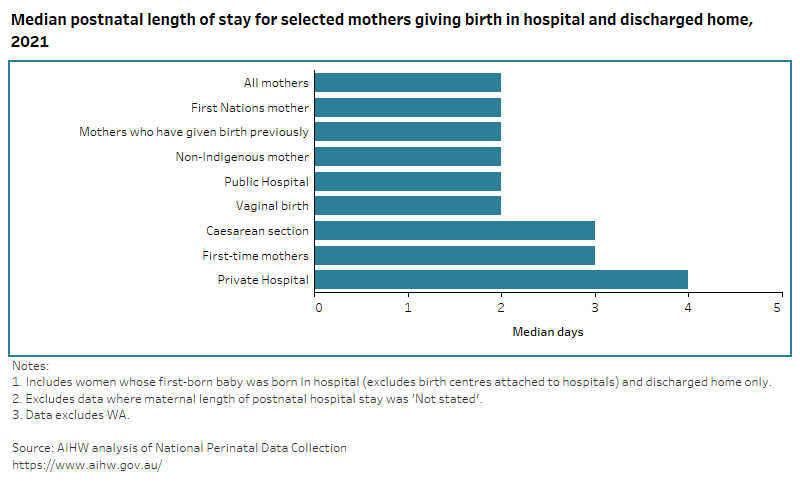Maternal length of stay in hospital
This section focuses on the maternal antenatal (prior to giving birth) and postnatal (after giving birth) length of stay in hospital, and is based on mothers who gave birth in hospital.
On this page:
Antenatal length of stay
Antenatal length of stay refers to the number of days between admission to hospital and giving birth.
An antenatal stay of one day or less indicates that pregnant women were most likely admitted to hospital for routine labour and birth (ACT Health 2003). Women who are considered to be at high risk due to antenatal complications, such as diabetes or hypertension, are more likely to be admitted to hospital for an antenatal stay of more than one day (Western Australian Department of Health 2007).
Over time, the average number of days women spend in hospital prior to giving birth has remained relatively stable (from 0.5 days in 2011 to 0.6 days in 2021).
Figure 1 presents data on the antenatal length of hospital stay for women who gave birth in hospital, by selected maternal characteristics, for 2021. Select the trend button to see how data has changed over an 11-year period (where available).
Figure 1: Proportion of women who gave birth in hospital, by antenatal hospital length of stay and selected topic
Bar chart shows antenatal stay by selected topics and a line graph shows topic trends between 2011 and 2021.

In 2021, most mothers had an antenatal stay of less than one day (59%).
Some groups had lower proportions of antenatal stay of less than one day, including mothers who:
- had a baby who was born pre-term (49%) or post-term (36%)
- were aged under 20 years (49%)
- had an instrumental vaginal birth assisted by forceps (38%) or vacuum (45%)
- had induced labour (33%)
- were first-time mothers (46%).
For more information on antenatal length of stay see National Perinatal Data Collection annual update data table 2.51.
Postnatal length of stay
Postnatal length of stay refers to the number of days between giving birth and date of discharge or transfer from the hospital where birth occurred, or death. Data on postnatal length of stay are based on mothers who were discharged to home and excludes data from Western Australia.
A mother’s postnatal length of stay is related to maternal factors, such as recovery after birth particularly for caesarean section birth, management of obstetric and maternal health conditions, management of conditions related to the baby and health system factors such as resourcing pressures (Rayner et al. 2008; Blumenfeld et al. 2015).
The World Health Organization (2022) recommends that after an uncomplicated vaginal birth in a health facility, healthy mothers and newborns should receive care in the facility for at least 24 hours after birth. The aims of postnatal care in hospital are to monitor the mother and baby after birth and to provide mothers and their partners and/or family with advice and support around physical recovery, breastfeeding, parenting skills and linking to supports in the community (Rayner et al. 2008; World Health Organization 2022).
The average number of days women spend in hospital following childbirth has steadily declined from 3.0 days in 2011 to 2.5 days in 2021.
Figure 2 presents data on the postnatal length of hospital stay for women who gave birth in hospital, by selected maternal characteristics, for 2021. Select the trend button to see how data has changed over an 11-year period (where available).
Figure 2: Proportion of women who gave birth in hospital, by postnatal hospital length of stay and selected topic
Bar chart shows postnatal length of stay by selected topics and a line graph show topic trends between 2011 and 2021.

In 2021, most mothers had a postnatal stay of 3 days or less (75%).
Higher proportions of postnatal stays of 3 days or less were seen among mothers who:
- had a baby who was born post-term (87%)
- were aged under 20 years (87%)
- had a non-instrumental vaginal birth (86%)
- had a parity of 3 (87%) or 4 or more (89%)
- had a singleton pregnancy (75%).
Higher proportions of postnatal stays of 4 days or more were seen among mothers who:
- had a baby who was born pre-term (41%)
- were aged 40 years and over (38%)
- had a caesarean section birth (39%)
- were first-time mothers (33%)
- had a multiple pregnancy (51%).
Some groups of mothers also have a longer median length of postnatal stay in hospital, which is reflected in Figure 3.
Figure 3: Median postnatal length of stay for selected mothers giving birth in hospital and discharged home
Bar chart shows median postnatal length of stay for mother who gave birth in hospitals and were discharged home.

There was a trend toward shorter postnatal stays between 2011 and 2021: 27% of mothers were discharged less than 2 days after giving birth in 2021 (17% in 2011), and 11% of mothers stayed 5 or more days (18% in 2011).
Mothers were most likely to be discharged between 2 and 4 days after giving birth (66% in 2011 and 62% in 2021).
For more information on postnatal length of stay see National Perinatal Data Collection annual update data tables 2.52 and 2.53.
ACT Health (2003) Maternal and Perinatal Health in the ACT 1999, ACT Health, ACT Government, accessed 26 July 2022.
Blumenfeld YJ, El-Sayed YY, Lyell DJ, Nelson LM and Butwick AJ (2015). Risk Factors for Prolonged Postpartum Length of Stay Following Cesarean Delivery, American Journal of Perinatology 32(9), doi:10.1055/s-0034-1543953
Rayner J, Forster D, McLachlan H, Yelland J and Davey M (2008). ‘A state-wide review of hospital postnatal care in Victoria, Australia: The views and experiences of midwives’, BMC Pregnancy and Childbirth, 24, doi:10.1016/j.midw.2006.10.008
Western Australian Department of Health (2007) Models of maternity care: updated review of the evidence, Western Australian Department of Health, Western Australian Government, accessed 26 July 2022.
WHO (World Health Organization) (2022) WHO recommendations on maternal and newborn care for a positive postnatal experience, WHO, accessed 25 July 2022.


